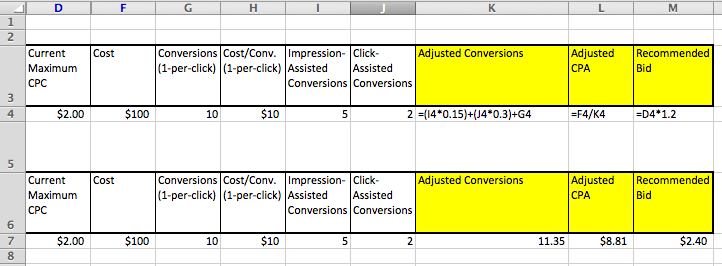Google has recently added search funnel data as a column in the AdWords interface. This data allows you to modify bids based on an impact a keyword has on both direct conversions (which have always been counting in the conversions column) and indirectly through a click that eventually led to a conversion through a different keyword or even an ad that got an impression from a user that eventually converted.
This is commonly known as attribution modeling (although a very simplistic form of it) and can lead to an overall lift in sales or leads if used correctly. This article is about how to use this data to make bid adjustments quickly and accurately.
I would quickly like to give a nod to one of our Google teams here, as they provided some recommendations that became the basis of this post. I don’t think I can name them but I will say that there is a team in New York that works in the Education vertical that will be getting a big pat on the back at Think EDU this year.
Here’s how to easily increase sales by adjusting bids based on assisted conversions and clicks:
- Go to the keywords tab.
- Change date range to last 90 days.
- Filter all keywords by any keyword with at least $10 in cost.
- Download a keyword report and make sure you include the following columns:
- Campaign
- Ad Group
- Keyword
- Current Max CPC
- Match Type
- Cost
- Conversions (either 1 per click or multi depending on which you use)
- Cost/Conv (either 1 per click or multi depending on which you use)
- Impression assisted conversions
- Click assisted conversions
5. Open the report in excel and add the following columns (leave data blank for now)
- Adjusted conversions
- Adjusted CPA
- Recommended bid
The headers for the spreadsheet will look something like this:
Determining how to weigh impression and click assisted conversions
The default recommendation I received from Google is to count impression assisted conversions as 15% of a true conversion and click assisted conversions as 30%. In my own experience I would say these are weighted a bit high and aim for counting an impression assisted conversion as 5% of a true conversion and a click assisted conversion as 20%.
It is going to take some trial and error on your part to determine the perfect mix for your account(s). If you are risk adverse I would start with my numbers and if you really want to test the limits I would start with Google’s. (For the rest of this article I am going to stick with Google’s recommendations any place it is pertinent.)
Calculating adjusted conversions and CPL
To calculate your adjusted conversions you simply multiply the number of impression assisted conversions by .15 and add that to the number of click assisted conversions multiplied by .3 and then add that number to the true number of conversions you had. It may sound confusing but let me illustrate how simple it is with an example.
Let’s say you had a keyword with:
- 10 conversions being reporting in the conversions (1 per click) column
- $100 in cost
- Thus a normal CPA of $10 ($100 / 10 = $10)
Now let’s say you also had:
- 5 impression assisted conversions
- 2 click assisted conversion
The math for adjusted conversions would be:
5 * .15 = .75
2 * .3 = .6
.75 + .6 + 10 = 11.35 adjusted conversions
Lastly, to determine your adjusted CPA you just take your total cost and divide it by your adjusted conversions.
$100 / 11.35 = $8.81 adjusted CPA
Below is what an excel doc doing all of this would look like. The top is showing the formula and the bottom is the actual calculations. (I have hidden non-essential columns for the sake of making it easier to read.)
Determining bid change percentage
Carrying out the example from above, if the ultimate CPA goal is $10, you have just found yourself $1.19 of wiggle room. That means you can increase bids by 11.9% (1.19 / a $10 goal CPA) and keep your adjusted CPA under goal.
On the opposite side, if an adjusted CPA is still above goal then the keyword should be bid down (or if way too far out of tolerance it should be paused.)
How to measure if it is working
The only way this method works is if volume grows and total (real) CPA stays at or below goal. If calculating adjusted CPA and then bidding up just raises cost and CPA without leading to more sales then it is not a method that you will want to continue using.
However, if over time you see that total sales volume increases and CPA stays below goal (even if the keywords that you are bidding up are now above goal) then this tactic is working and you should keep it up!





